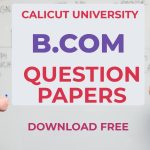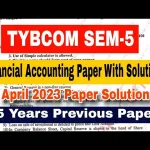M Com Question Papers with Answers PDF
Master of Commerce (M.Com) is a postgraduate program covering advanced topics in commerce, economics, and business management. Solving previous question papers with answers can help students prepare effectively for exams. Below are sample questions and answers across various subjects to assist with preparation.
Accounting for Managerial Decisions
Question: What is managerial accounting?
Answer: Managerial accounting involves providing financial and non-financial information to managers to help them make informed decisions.
Question: Define marginal costing.
Answer: Marginal costing is a cost accounting technique where only variable costs are considered for decision-making purposes.
Question: What are financial statements?
Answer: Financial statements are formal records of financial activities, including the income statement, balance sheet, and cash flow statement.
Question: Explain the concept of break-even analysis.
Answer: Break-even analysis determines the sales level at which total revenue equals total costs, resulting in no profit or loss.
Question: What is budgetary control?
Answer: Budgetary control is a process where budgets are prepared and continuously monitored to ensure financial goals are achieved.
Question: Define the term working capital.
Answer: Working capital is the difference between current assets and current liabilities, representing liquidity available for daily operations.
Question: What is variance analysis?
Answer: Variance analysis compares actual financial outcomes with budgeted figures to identify discrepancies and their causes.
Question: Explain activity-based costing (ABC).
Answer: ABC is a costing method that assigns overhead costs to products based on activities driving costs rather than traditional allocation methods.
Question: What is the purpose of a cash flow statement?
Answer: A cash flow statement provides details of cash inflows and outflows over a specific period, helping in liquidity assessment.
Question: What are fixed and variable costs?
Answer: Fixed costs remain constant regardless of production levels, while variable costs change proportionally with output.
Question: Explain the term operating leverage.
Answer: Operating leverage measures how changes in sales volume impact operating income due to the presence of fixed costs.
Question: Define cost-volume-profit (CVP) analysis.
Answer: CVP analysis examines the relationship between costs, sales volume, and profits to help in decision-making.
Question: What is a responsibility center?
Answer: A responsibility center is a part of an organization accountable for its own revenues and expenses.
Question: What is the meaning of absorption costing?
Answer: Absorption costing includes all production costs, both fixed and variable, in the cost of a product.
Question: Explain the term profit margin.
Answer: Profit margin is a financial ratio indicating the percentage of revenue that exceeds costs.
Question: What is depreciation?
Answer: Depreciation is the reduction in value of an asset over time due to wear and tear or obsolescence.
Question: Define the term capital budgeting.
Answer: Capital budgeting involves evaluating and selecting long-term investment projects based on their potential returns.
Question: What are the limitations of ratio analysis?
Answer: Limitations include reliance on historical data, non-comparability across industries, and ignoring qualitative factors.
Question: What is a flexible budget?
Answer: A flexible budget adjusts budgeted figures based on changes in actual activity levels.
Business Economics
Question: Define the law of demand.
Answer: The law of demand states that, ceteris paribus, the quantity demanded of a good decreases as its price increases.
Question: What is elasticity of demand?
Answer: Elasticity of demand measures the responsiveness of quantity demanded to changes in price or other factors.
Question: Explain the concept of opportunity cost.
Answer: Opportunity cost is the value of the next best alternative foregone when making a decision.
Question: What is perfect competition?
Answer: Perfect competition is a market structure with many buyers and sellers, identical products, and no barriers to entry.
Question: What is meant by monopolistic competition?
Answer: Monopolistic competition is a market structure where many firms sell similar but not identical products.
Question: Define GDP.
Answer: Gross Domestic Product (GDP) is the total monetary value of all goods and services produced within a country in a specific period.
Question: What is the difference between microeconomics and macroeconomics?
Answer: Microeconomics studies individual economic units, while macroeconomics examines the economy as a whole.
Question: What is fiscal policy?
Answer: Fiscal policy involves government adjustments in spending and taxation to influence the economy.
Question: Explain the term inflation.
Answer: Inflation is the rate at which the general level of prices for goods and services rises over time.
Question: What is the meaning of supply?
Answer: Supply refers to the quantity of a good or service that producers are willing to offer at various price levels.
Question: Define price discrimination.
Answer: Price discrimination occurs when a seller charges different prices to different customers for the same product or service.
Question: What is a production possibility curve?
Answer: A production possibility curve represents the maximum combinations of two goods that an economy can produce with given resources.
Question: What is meant by economic equilibrium?
Answer: Economic equilibrium is a state where demand and supply are equal, resulting in stable prices.
Question: What is a public good?
Answer: A public good is non-excludable and non-rivalrous, meaning its consumption by one person does not reduce availability for others.
Question: Define the term marginal utility.
Answer: Marginal utility is the additional satisfaction gained from consuming one more unit of a good or service.
Question: What is comparative advantage?
Answer: Comparative advantage refers to the ability of a country to produce a good at a lower opportunity cost than others.
Question: Explain the concept of diminishing returns.
Answer: Diminishing returns occur when adding more of one factor of production results in smaller increases in output.
Question: What is the meaning of trade surplus?
Answer: A trade surplus occurs when a country’s exports exceed its imports.
Question: What is the role of the WTO?
Answer: The World Trade Organization (WTO) promotes global trade by reducing trade barriers and resolving disputes.
Continue for additional subjects such as Financial Management, Marketing Management, Human Resource Management, etc.
M Com exams often cover diverse topics and require a thorough understanding of concepts. Practicing question papers with answers aids in revising topics effectively and improving performance.
Latest Posts
- Step-by-step guide to download and apply for jee mains admit card 202
- Comprehensive 2025 government holidays and recruitment details for job seekers
- JEE Mains Admit Card 2025: Your Step-by-Step Guide to Downloading the Hall Ticket
- Everything You Need to Know About 2025 Government Holidays Recruitment
- Comprehensive Guide to rrb d group recruitment 2025 – Eligibility, Vacancies, and Application
- Detailed guide to nps trust recruitment 2025 vacancies, eligibility and apply process
- Comprehensive guide to hpcl recruitment 2025 notification, vacancies, and application process
- ignou bed admission 2025 complete recruitment guide with eligibility and process
- Comprehensive Guide to Indian Army Agniveer Recruitment 2025 Notification and Jobs
- Everything You Must Know About CBSE Board Exams 2025 Changes & New Rules






